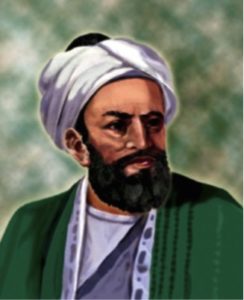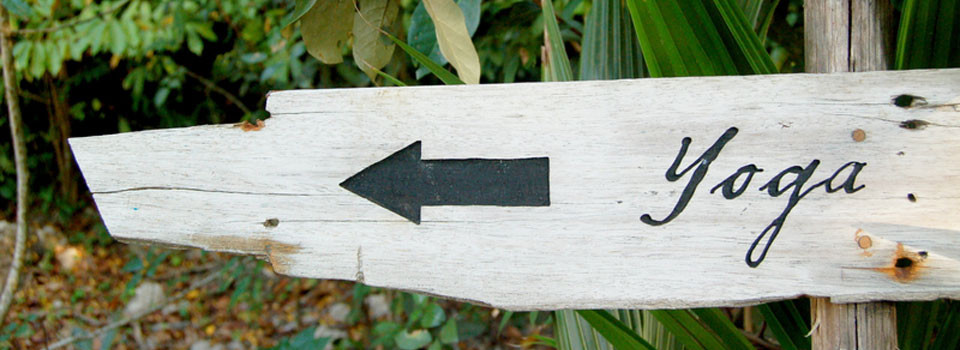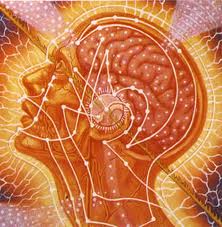Introduction
Dr. Bhushan Jathar, a well-known Physician, Ayurvedic doctor practicing for past 60 Years in Gokarna. He is considered an outstanding figure in the history of Ancient Indian Sciences. A News Article once called him “father of eastern medicine” in the region in recognition of his lasting contributions to the field as the founder of revolutionary medicinal therapy through his immense experience and intense experiments. He is a public speaker, social influencer, an economist, thinker, and teacher. As per him a doctor’s responsibility is not restricted to his own clinical practice, but it is also towards influencing social harmony from healthy education, balanced economy, organised infrastructure, and overall wellbeing of the society he resides in. His teachings are on thought processes concerning humankind. In his early life he was groomed to be a Vedic priest but later received his education in Ayurveda, which lead him to towards helping society to evolve.
Dr. Jathar is commonly portrayed as the paragon of ancient Indian sciences and credited with coining his own methods in Physiopsycic therapy. He is also credited with greatly advancing the systematic study of human psyche in close equation with matter and consciousness through his clinical experiments, summing up the medical knowledge of previous schools, prescribing practices for physicians through his works.
The Society, which benefited from his treatment methodology and teachings portray him as a “ Kind, dignified, holy doctor “. We like to describe him as an “ Ideal physician of experience, a man of great degree of common sense and wisdom ”.
Dr. Bhushanji’s theory
As a Medical practitioner he has seen both modern and ancient practices, He can be credited as the first person to believe that diseases are caused naturally, not because of superstition and gods. Although belonging to Vedic Society and associated with Temple Authority as trustee, he separated the discipline of medicine from religion and its rituals. He believes in the argument that diseases are a not a punishment inflicted by Gods but rather the product of environmental factors, diet, and living habits. There is not a single mention of a mystical illness in the entire of his corpus.
As per him, Ayurveda is not only an herbal medicine but it has and can have the power of curing most ailments related to humankind. It needs further research in order to blend its benefits along with modern allopathic medicine along with various other healing methodologies available in the world to create one integrated approach within medical education, science, research and medicinal practice.
Dr.Bhushanji’s Methodology is derived from the thought that a complete knowledge of the nature of the body is necessary for medicine and treatment. Nature he means physical, physiological, psychological aspects involving Body and Mind. Bhushanji’s medicinal techniques are notable for its strict professionalism, discipline and rigorous practice. We observed his treatment procedures always are well defined, honest, calm, understanding and serious. He follows detailed diagnostics of his patients. He believes that a doctor has to be healthy first in order to treat his patients. He maintains his regime of cleanliness, self-psychophysical fitness and continuous knowledge upgrade through experiments and studies.
Face and Palm Therapy © (FPT)
FPT is one of the products of Dr. Bhushanji’s relentless experiments. It is a psychic practice that can be used as a quick tranquilizer, a pace maker for psychophysical healing, a regular practice to influence holistic health and as a vital tool to raise your consciousness to higher levels.
Anatomy and physiology
Modern neurophysiologist have been able to demonstrate an obvious relationship between the body and brain which was first recognized by the ancient sages thousands of years ago. Using stimulating electrodes to probe the brain surface, neurosurgeons have shown that each part of the body is precisely mapped out along the surface of the central gyrus or fold of the sensory motor cortex of the brain.
The brain is a physical mediator of consciousness, linking mind, body, and emotions in to one harmonious unit. Neurosurgeon’s treat the body by stimulating the brain. But the practices of FPT begin at the other end of nerve pathway by heightening the awareness of the face and palm in order to stimulate the brain. The progressive movements of awareness through palm and face induces physical relaxation, but also clears all nerve pathways to the brain, both those governing the physical activity and those concerned with incoming information. At the same time we make the total run through the brain surface from inside out. In this way FPT relaxes the mind by simple and easy methods.
The Cortical Homunculus or “ Little Man”
Researches have named this neural map or hologram of the physical body existing within the cerebral white matter, the sensory and motor homunculus or “ Little Man”. All the body parts through which the awareness passes during rotation of consciousness can be located there, for example: Right hand thumb, second finger, third finger, forth finger, firth finger, palm of the hand, back of the hand, wrist, elbow, shoulder, armpits, right side, right waist, right thigh, kneecap, calf muscle, ankle, heel, sole, big toe, second toe, third toe, fourth toe, fifth toe.
However, in terms of brain tissue, importance has been placed upon the hands, fingers, lips and nose which occupy areas far in excess of the relative size and dimensions of those parts in the physical body and it is these same areas which receive added emphasis during cyclic or random rotation of consciousness in FPT. Its is observed that these areas receive intense emphasis even without rotation by just being aware of the warmth feeling of your breath while in FPT.
These areas are most as large as the space allotted to the entire remainder of the body from the wrists to the toes.

Cross Section of the brain
By Physical standards, the motor homunculus is a little man of grotesque proportions, with enormously enlarged hands, fingers and facial features. He exists as a neuronal abstraction of physical body, operating the realm of neurotransmission and conscious electrical energy flowing throughout the central nervous system and the network of nadis, which form the pranic body.
Now we can begin to understand why the position of hand close to face is so important in this practice of FPT. Once this position is established it shouldn’t be altered, as it induces flow of energy within the neural circuit of the motor homunculus. This flow is accompanied by a subjective experience of release or “ Letting go”, as spontaneous dissociation of Consciousness from the sensory and motor channels of experience occurs. Familiarity and daily repetition of this practice exerts a rapid inturning effect upon the normally fragmented and dissipated awareness.
This state of withdrawal of sense consciousness is an important part of FPT, which acts as a prelude to further advanced practice stages.
How Face and Palm Therapy © (FPT) helps in restoring health
It is impossible to ignore the connection between the discoveries of modern brain researchers and those of the enlightened sages like Dr. Bhushanji who evolved the practice of FPT. Of course Dr. Bhushanji devised this powerful technique merely as a means of alleviating diseases, But later practitioners realized this as a way of attaining higher consciousness by expanding and liberating individual awareness from its fixation within the physical body and its sensory modalities, towards the more subtle pranic, psychic and spiritual dimensions underlying our gross existence.
However, in the context of modern man suffering from stress- related diseases, it is sufficient to recognize that these originate out of excessive identification of the psyche with the soma (material body), through the medium of the sensory channels leading to nervous depletion and even breakdown. In FPT, this destructive psychosomatic tendency is effectively alleviated by the opposite somatopsychic route. The Psychosomatic imbalance is restored spontaneously due to liberation of nervous energy, which is withdrawn from the sensory channels and modalities as this special state is attained. This energy is redirected for healing and rejuvenation of overtaxed tissues, glands and organs.
Helpful in faster recovery of many psychosomatic diseases like stomach ulcers, high blood pressure, heart disease, hypertension, respiratory ailments, gastrointestinal disturbances, migraine and tension headaches, pelvic pain, impotence, frigidity, dermatitis, and ulcers
Psychosomatic disorder
Psychosomatics disorder, also called Psychophysiological disorder, a condition in which psychological stresses adversely affects physiological (Somatic) functioning to the point of distress. It is a condition of dysfunction or structural damage in bodily organs through inappropriate activation of the involuntary nervous system and the glands of internal secretion. Thus the psychosomatic symptom emerges as a physiological concomitant of an emotional state. In a state of rage, for example, the angry persons blood pressure is likely to be elevated and his pulse and respiratory rate to be increased. When the anger passes, the heightened physiological processes usually subside. If the person has persistent inhibited aggression (Chronic rage), which he is unable to express overtly, the emotional state remains unchanged, though unexpressed in the overt behavior and the physiological symptoms associated with the angry state persist. With time, such a person becomes aware of the physiological dysfunction. Very often he develops concern over the resulting physical signs and symptoms, but he denies or is unaware of the emotions that have evoked the symptoms.
Psychosomatic disorders may affect almost any part of the body. Though they are usually found in systems not under voluntary control. Research by psychiatrist Franz Alexander and his colleagues at the Chicago Institute of Psychoanalysis in the 1950s and 1960s suggested that specific personality traits and specific conflicts may create particular psychosomatic illnesses, but it is generally believed that the form a disorder takes is due to individual vulnerabilities. Emotional stress is assumed to aggravate existing illnesses, and there is some evidence that it may precipitate illnesses not usually considered to be psychosomatic (e.g., cancer, diabetes) in individuals predisposed to them.
Psychosomatic disorders resulting from stress may include hypertension, respiratory ailments, gastrointestinal disturbances, migraine and tension headaches, pelvic pain, impotence, frigidity, dermatitis, and ulcers.
Many patients suffering from psychosomatic diseases respond to a combination of drug therapy, psychoanalysis, and behavior therapy. In less severe cases, patients can learn to manage stress without drugs. FPT has proven results in both the above scenarios.
Therapy Steps & Methods
Step I
It is very simple method. Patients can practice on their own after learning from an expert therapist or a doctor.
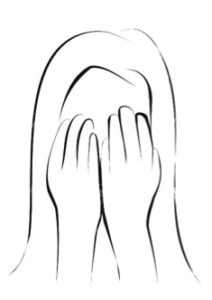
First Stage of FPT – Face Covered with Palms. Keep your Eyes Closed through the practice, observe the warmth feeling of your breath, and feel secured with your palms covering your face gently.
Step II: Release your hands, Keep your Eyes Closed, keep your breath normal and observe your breath.
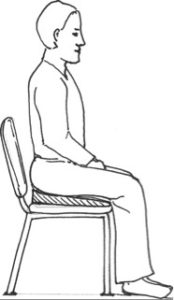
Second Stage of FPT – Releasing Hand free on your Lap. Leaning back on a more comfortable chair may also work but be aware it is more likely that you will slip into drowsiness instead of practice. A ‘kneeling chair’ may also be used. There are various designs of these marketed to people suffering from back pain, and they may also be suitable for this practice.
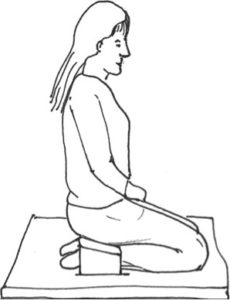
A kneeling position with the body weight supported on a cushion or kneeling bench works well for many.
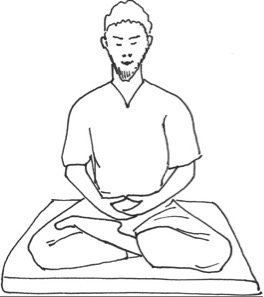
Any Comfortable posture can be adopted.
Note:
This technique needs to be practiced for minimum of 1 minute. And Release after one minute. Strictly do not hold any Mudras nor recite any Mantra’s, as this is not an extract of any Yogic, Vedic or any religious ritualistic practices. One can again practice in repetitive manner. Keep your mind Calm and body in any steady sitting posture.
Dr. Bhushanji has derived this technique from his 60 years of experience in clinical experiments and medical practice field. Also it has been observed and its results helping in recovery and faster healing of several psychosomatic ailments have been appreciated by the society.
References
